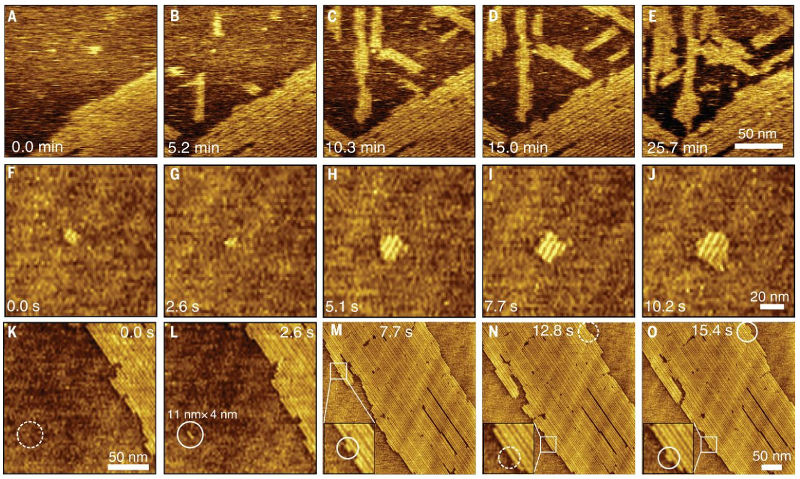AFM Systems
AFM Accessories
Learning
Contact Us
 Part of the Oxford Instruments Group
Part of the Oxford Instruments Group
Researchers used high-resolution, in-situ AFM imaging to monitor the self-assembly dynamics of 1D peptide crystals on an MoS2 surface. They found that 2D arrays grew one row at a time, a result that upholds the principles of classical nucleation theory.
Two-dimensional (2D) materials formed by assembling molecular arrays on surfaces display a wide range of unique and exotic properties. Yet their nucleation—the first step in their formation—has been given scant attention.
A team of U.S. and Chinese researchers investigated this issue in more detail with high-resolution, in-situ AFM imaging. They examined how short protein fragments called peptides nucleate on the surface of MoS2 from solution into 2D crystals.

Molecular-resolution images and high-speed movies revealed that crystal formation initiated from ordered nuclei and assembled one row at a time. Comparison of AFM data to molecular dynamics simulations showed the nuclei formed without a free energy barrier or a critical size.
These results confirm long-standing but unproven predictions of classical nucleation theory, which were developed by Gibbs over a century ago. Further, they lend new insight that could facilitate the design and production of new microelectronic devices, membranes, and even tissues.
Cypher ES and Cypher VRS
The experiments used MoSBP1 peptides, which contain the seven amino acids Tyr-Ser-Ala-Thr-Phe-Thr-Tyr (YSATFTY). Topography images were acquired on the Cypher ES AFM in tapping mode to probe the structure and ordered arrangement of peptides as they attached to the surface from solution. As seen in the images, the ES captures fast, high-resolution, stable images while operating in a controlled liquid environment. In addition, high-speed topography movies of nucleation and growth processes were acquired with the Cypher VRS AFM in tapping mode. The VRS enables imaging at up to 625 lines per second with the same high resolution and ease of use as other Cyphers. The movie shown was acquired at 2.56 seconds per frame and is played at 10x speed.
Citation: J. Chen, E. Zhu, J. Liu, et al., Building two-dimensional materials one row at a time: Avoiding the nucleation barrier. Science 362, 1135 (2018). http://doi.org/10.1126/science.aau4146
Note: The data shown here are reused under fair use from the original article, which can be accessed through the article link above.
